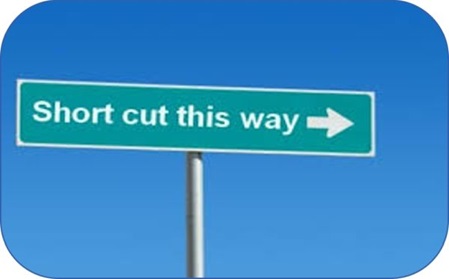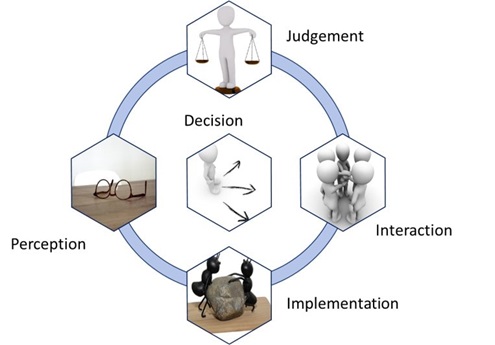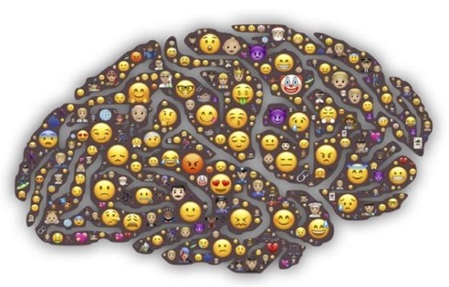Background to cognitive biases - system 1 and system 2
Today's world poses new challenges for our brains
We live in a dynamic, increasingly connected and thus more complex world.
The acceleration, intensification and increased demands are a result of developments over the last 200 years. However, our brain was formed at a time when all these issues were not yet relevant.
Intensive research on the exciting topic of "How does our brain work" has impressively shown that:
- our brain does much more than we previously assumed;
- we understand its functioning better and better thanks to modern research methods;
- our brain works very efficiently, filtering information and using a wide variety of patterns;
- our daily behaviour and decisions are essentially shaped by these patterns;
- our brain works mainly with thinking shortcuts, but cannot decide between important and unimportant information;
These processes run unconsciously, so we don't notice them automatically!

System 1 and system 2 - a metaphor for the way our brain works
Our brain is an impressive organ - and probably the decisive reason that we as humans have been able to assert ourselves evolutionarily.
A key characteristic of our brain is the way in which it processes information and its efficiency in doing so.
Nobel Prize winner Daniel Kahneman described the functioning of the human brain as the interaction of two systems of thought - system 1 and system 2.
"System 1" - for simple tasks our autopilot runs
Kahneman calls the unconscious, fast, automatic and intuitive functioning of our brain "system 1". It is based on heuristics, which in turn are based on experiences as well as thought patterns formed from them.
System 1 works extremely efficiently by filtering external information, comparing it with stored patterns and deriving actions. This autopilot takes more than 90% of our decisions without us noticing.
System 1 has done well evolutionarily because it allows for quick reactions and has therefore been central to the survival of our species in dangerous situations. We notice it in our quick reactions in dangerous situations (such as in traffic).
It works error-free if the patterns fit the respective context - this is usually only the case with low complexity.
"System 2" - complex questions require conscious activation of our brain
Complex questions need a different approach. Our brain can also work logically, slowly and analytically for this purpose ("system 2" according to Kahneman). We tend to identify strongly with this part of our thinking (hence - the ratio). However, research has proven that we consciously activate this System 2 much less often because it takes a lot of energy and tires quickly.
Daniel Kahneman emphasises that our decisions, our interaction with other people and our behaviour are very much shaped by the interaction of the two systems. At the same time, he emphasises that this is a metaphor. The actual way our brain works is much more complex.
System 1 and System 2 can be used very well as a concept to explain the presence of cognitive biases - our autopilot sometimes goes wrong.


What are heuristics?
A heuristic is the ability to arrive at workable solutions or useful statements with limited knowledge and / or little time.
The quality of the conclusions reached can be determined by comparing them with an optimal solution.
In contrast to heuristics, an algorithm represents a systematic, logical rule or procedure for solving a specific problem. As a rule, more time is available for this.
System 1, system 2 and the origin of cognitive biases
As discussed in the definition of unconscious biases, we are sometimes systematically wrong. Why?
Essentially, we apply an existing pattern that is not appropriate in the specific context. System 1 is equally convinced of its correctness, system 2 does not engage.
The consequence: our judgement, decision or action leads to a result that is inappropriate for the situation - for ourselves, other people or organisations. This can also happen contrary to system 2's conscious beliefs or values, therefore also contrary to an actual intention.
Due to the unconscious nature of system 1, people tend to underestimate its scope and effect, correspondingly the impact of biases on themselves or their environment.
A second key point - unconscious biases are always based on individual patterns. Every person has a multitude of biases, and the extent and interaction of these biases are unique.
Therefore, measures against unconscious biases must always be individual - "one size fits all" does not work!
Therefore - our autopilot guides us through life largely error-free, but we must be aware of the following:
- Our perceptions, judgements and decisions can run decidedly contrary to our rationale or self-assessment without us noticing.
- These deviations are called unconscious biases or cognitive distortions.
- These biases are systematic and predictable, they are deeply rooted in our thinking patterns.
- We all have a wide variety of thinking biases that vary from person to person.
- The impact of our biases is a matter of context (i.e. how problematic it is to make mistakes) and not a matter of fact (i.e. biases cannot be turned off on command).
Examples for system 1 and system 2
System 1:
- Recognise that one object is further away than another
- 1 +2 = ?
- Recognising hostility from a voice
- Completing the phrase "bread and ..."
- Turning towards the source of a sudden noise
System 2:
- Focusing on a voice in a crowded, noisy room
- Telling someone your phone number
- 24 * 19 = ?
- Searching memory to identify an unfamiliar sound
- Paying attention to one's own behaviour
Reinforcing factors - why unconscious biases are becoming more relevant
About 200 different biases have been identified that influence our daily actions.
Their effect continues to grow - the immense demands in teams and on leaders have a reinforcing effect.
The ever-increasing flood of information, time pressure, greater uncertainty and multitasking massively amplify this phenomenon.
Our brain reacts in stressful situations in such a way that automatic patterns become more dominant. This means that external stimuli are answered with the existing patterns. The brain falls back on available, stored heuristics - system 1 largely takes over.
In evolution, this behaviour has proven itself - in today's situations of stress, crises or professional overload, the narrowed way of thinking means the concrete risk of making more wrong decisions.
Especially in today's working environments, complexity and speed have increased greatly - system 2 as our special capacity would be in demand here.
Unconscious biases will become more and more relevant and cause effects in all five areas of influence. They will show up in the personal sphere, they will trigger negative consequences in companies.
What can be done effectively against them?

Science & Marketing
The topic of unconscious thought patterns and their distortion is based on a wide range of sciences, especially brain research, psychology and behavioural economics.
In recent years, there has been an increasing trend to use the term "neuro" to market a wide variety of services. On closer inspection, this often hides theories that have long been outdated, but which are nevertheless advertised under the label "state of the art in science".
In the online format "Popular errors about the brain", some of these popular myths and marketing claims have been analysed and corrected - feel free to contact me if you are interested in the content used!
What can we do against unconscious biases?
Biases work unconsciously and due to different, individual patterns in many different ways.
It therefore takes equally extensive measures to reduce their negative effects.
We can basically start again with System 1 and System 2 and define the following goals:
- To be able to activate System 2 when we need it.
- To further develop System 1 in order to gradually rebuild or redevelop patterns and automatisms.
The first, essential step is to develop greater awareness of thinking errors and biases.
Awareness and clarity for self-control and self-direction
On a personal level, the main issues that affect us are perception (i.e. what is my reality), judgement and choices. We all have the choice to deal with our most personal imprints, thought patterns and prejudices, thus with the foundations of our biases. The more awareness and clarity we build up, the more we take on self-control and responsibility for ourselves - not least, one of the most important principles of the ancient Greeks is "Know thyself!".
At the level of organisations and companies, a wide variety of individuals play together, interaction is quite essential. Predefined solutions do not work here, it takes a deep examination of structures, anchored biases and priorities. Companies can differentiate themselves from others by improving precisely these factors - there is great potential here in many organisations!
De-biasing is a comprehensive & innovative concept to counter biases at various levels. It is based on the fact that changes in patterns and behaviour are a process - not an isolated event that is sometimes conveyed through Unconscious Bias Trainings.
Learn more about the de-biasing concept for your path to better decisions and positive results!

De-biasing instruments and solutions
Here you will find further information on all instruments and solutions - for you, for your team and for your organisation.
- Key notes & impulse lectures
- Impulse series
- Free information lectures
- Workshop formats
- Business Coaching
- Business Sparring
- Business Consulting
